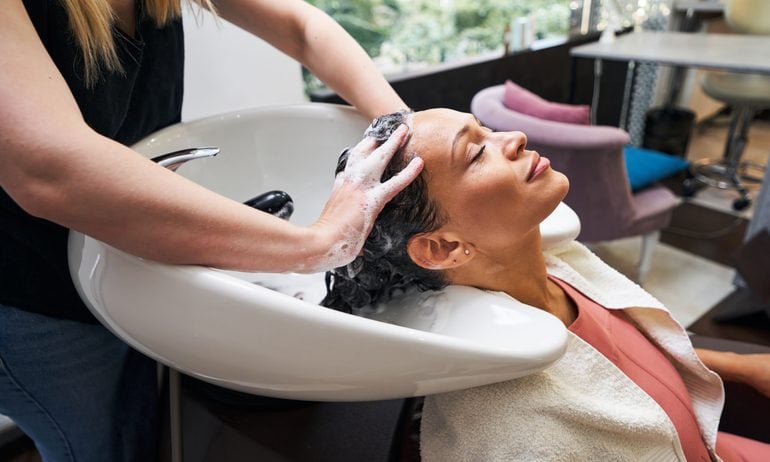How Much Do You Tip a Hairdresser?

Many, or all, of the products featured on this page are from our advertising partners who compensate us when you take certain actions on our website or click to take an action on their website. However, this does not influence our evaluations. Our opinions are our own. Here is a list of our partners and here's how we make money.
Not sure how much to tip your hairstylist? It’s a common uncertainty. Heading to your appointment with a number in mind can alleviate that. We’ll keep it simple for you. The tipping standard is usually 20%.
How much should you tip your hairdresser?
We asked three etiquette experts, two salon professionals and a certified financial planner. Most of these experts suggest leaving 15% to 20%, depending on the service and your satisfaction.
Going with 20% is nice for the stylist and you because that math is pretty simple.
To find 20%, start by finding 10%, then double that amount. So, if your haircut costs $60.00, find 10% by moving the decimal one digit to the left. Ten percent of $60 is $6. Then double that $6 to arrive at your 20% tip: $12.
Or, go even simpler and try our tip calculator.
Do you have to tip a hairdresser?
For many hairstylists, tips make up a significant portion of their earnings. That amount “affects the way they think about their income and how they’re going to allocate it for their expenses,” says Steve Waldman, technical artistic director and product consultant for Hair Cuttery Family of Brands.
Tips also show appreciation for your hairdresser, whose job likely changed and became riskier during the pandemic. With COVID still a concern, it’s worth considering the extra steps stylists now may take to protect themselves and others when deciding how much to tip, says Crystal L. Bailey, director of The Etiquette Institute of Washington, which is in D.C.
» MORE: How much to tip at a nail salon
Are there exceptions to the 15%-20% rule?
Sure, 15% to 20% is the general rule (and is also how much to tip a massage therapist.) But if you can afford to tip a little more than 20%, Waldman suggests doing so for styles that are “really intuitive and relying on the creativity and expertise of your stylist.” For example, he says, consider tipping more for hand-painted highlights, corrective coloring and hair extensions.
By contrast, it’s acceptable to tip closer to 15% for simpler styles, like a routine barber cut, Waldman says.
» MORE: How much to tip just about everyone
What do you tip if you’re unhappy with the result?
If you're not pleased with how your hair turned out, it’s OK to leave closer to 15%, but do not skip the tip, says Diane Gottsman, founder of The Protocol School of Texas. After all, she says, the professional still put in the time and effort and may not even realize there’s a problem.
Forgoing a tip or silently leaving the salon won’t make your hair look better — but speaking up could. As Waldman puts it: “Give the salon professional an opportunity to get you to a place where you’re happy with your hair.”
Talk privately with your hairstylist about what, specifically, you’re dissatisfied with and ask what could be done differently, suggests Elaine Swann, founder of the Swann School of Protocol, based in Carlsbad, California. “This way, there’s a dialogue, and you’re seeking a resolution.”
Maybe you can schedule a follow-up appointment to adjust the color, for example, or your professional can offer styling tips or products to spruce up an unfortunate cut.

Do you tip assistants?
A general rule offered by both Waldman and Gottsman is to tip anyone who touches your hair. So, no need to tip the salon coordinator who checked you into the appointment. But if you can, give about $3 to $5 to the assistant who shampoos your hair or rinses color from it.
» MORE: How much to tip a dog groomer?
What if you can’t afford to tip?
Our experts offered a couple of different views on what to do if you can't afford the tip. While tipping is a “very, very nice gesture,” Swann says, “if you’re not able to leave a tip, then so be it.” In other words, say thank you and leave without tipping.
The cost of the service is all that’s owed, says Swann, who used to own a beauty salon.
Niki Moon, who owns Niki Moon Salon & Spa in Naperville, Illinois, has a similar view. “Tips are always appreciated, but never expected,” she says. “We would never want a client to not come see us because they couldn’t afford to pay the tip on top of their service.”
Gottsman has a different answer. “Gratuity is not optional,” she says. “It’s not a to-go order — they’re cutting your hair.” She points out that you’re choosing to get this experience, which involves tipping. So it would be best if you planned to do so.
Pamela Capalad, a New York-based certified financial planner, is in the same camp. “You can’t just pay what it says on the cash register,” Capalad says. “If you are planning to use these services, you need to add a tip to your budget.”
How can you take the guesswork out of tipping?
Before making an appointment, look at the money you have free to spend. For example, if the service you want is $100, do you feel comfortable spending $115 or $120 total to account for a 15% or 20% tip?
“If you are in a financial bind, perhaps you may rethink your experience,” Gottsman says. Maybe you stick with that $120 expense but go to the salon less frequently. Or perhaps you look into a less expensive service or salon. For example, a $75 service plus 20% tip would still keep you in the double digits at $90.
Or you may try to tweak the way you manage your money. For example, perhaps you find an opportunity to spend less on other expenses to free up money for the salon. Or regularly stash cash in a salon fund to save up for these services.
Whichever way you pay for salon services, aim to tip — and show kindness. For example, use your hairstylist’s name, Gottsman says, and if you’re stoked about your new do, let their manager know or post a glowing online review.

